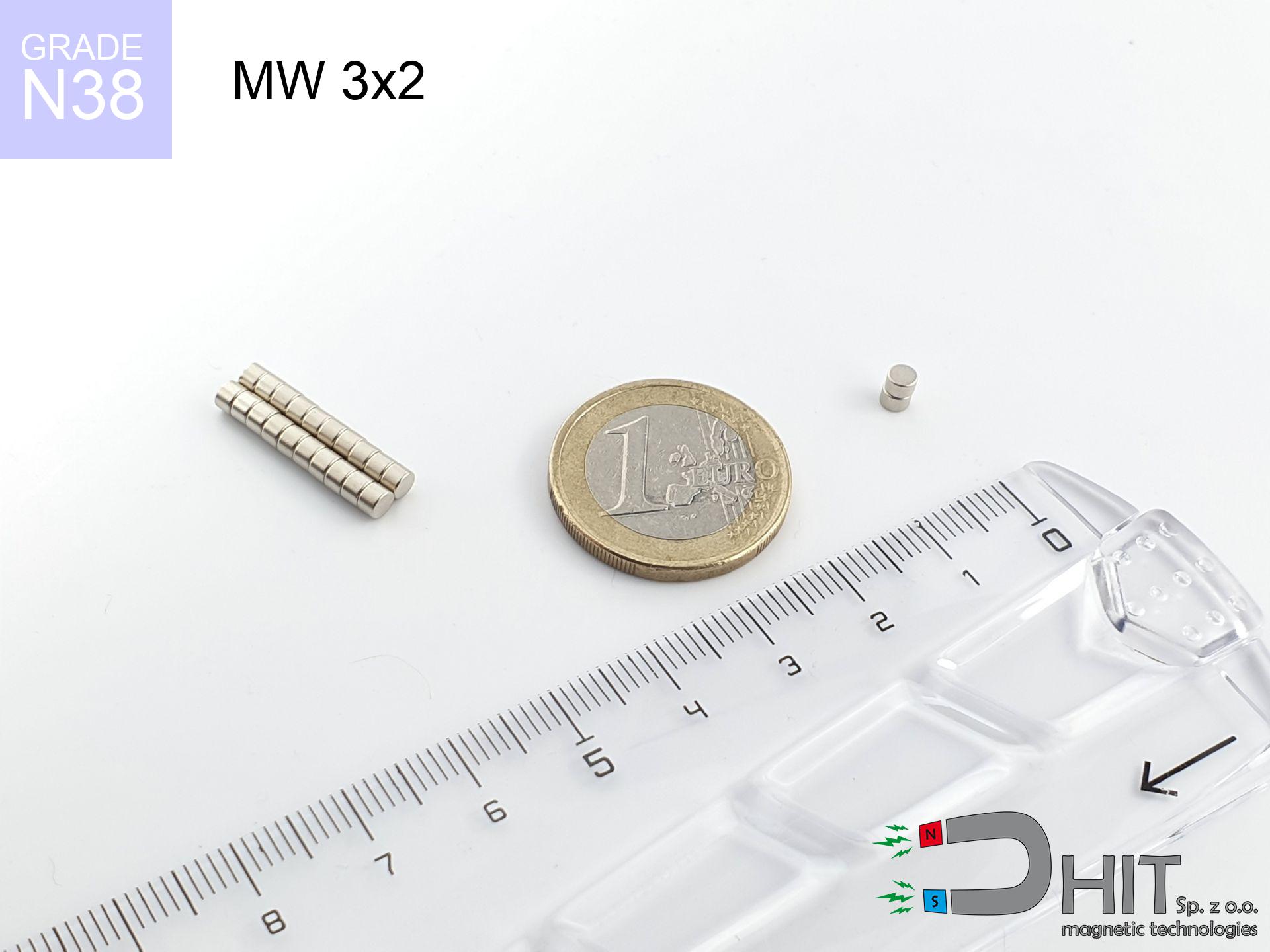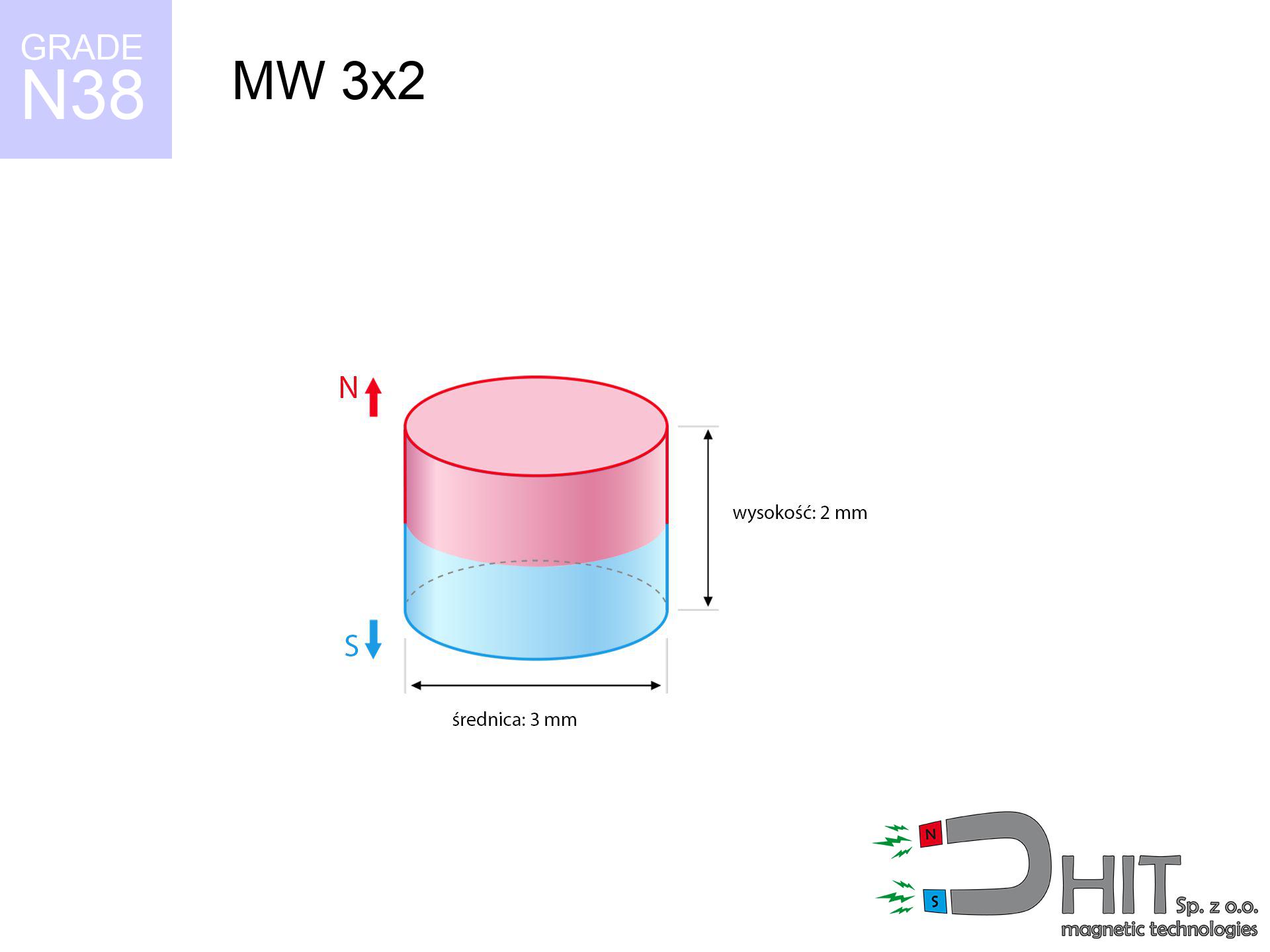MW 3x2 / N38 - neodymium magnet
cylindrical magnet
catalog number 010064
GTIN: 5906301810636
diameter Ø
3
mm [±0,1 mm]
height
2
mm [±0,1 mm]
magnetizing direction
↑ axial
capacity ~
0.33 kg / 3.24 N
magnetic induction ~
493.99 mT / 4,940 Gs
max. temperature
≤ 80
°C
catalog number 010064
GTIN: 5906301810636
diameter Ø
3 mm [±0,1 mm]
height
2 mm [±0,1 mm]
magnetizing direction
↑ axial
capacity ~
0.33 kg / 3.24 N
magnetic induction ~
493.99 mT / 4,940 Gs
max. temperature
≤ 80 °C
0.16 ZŁ gross price (including VAT) / pcs +
0.13 ZŁ net price + 23% VAT / pcs
bulk discounts:
need more quantity?Want to talk about magnets?
Call us tel: +48 888 99 98 98 or get in touch through contact form on our website. You can check the strength as well as the shape of neodymium magnet in our magnetic calculator force calculator
Orders placed by 2:00 PM will be shipped on the same business day.
Specification: cylindrical magnet 3x2 / N38 ↑ axial
Magnetic properties of the material N38
Physical properties of sintered neodymium magnets Nd2Fe14B
Moreover, even though neodymium is part of the strongest magnets, they are susceptible to corrosion in humid environments. For this reason, they are coated with a thin layer of nickel to protect them from corrosion. Interestingly that NdFeB neodymium magnets are about 13% lighter than SmCo magnets and, despite their power, easily break, which requires care during their handling. For this reason, any mechanical processing should be done before they are magnetized.
In terms of safety, there are several recommendations regarding the use of these magnets. It is advisable to avoid their use in acidic, basic, organic environments or where solvents are present, as well as in water or oil. Furthermore, they can distort data on magnetic cards and hard drives, although data deletion using a neodymium magnet is not guaranteed.
In terms of properties in different environments, neodymium magnets are susceptible to corrosion, especially in humid conditions. Therefore, they are often coated with coatings, such as epoxy, to preserve them from environmental factors and extend their lifespan. High temperatures exceeding 130°C can result in a reduction of their magnetic properties, although there are particular types of neodymium magnets that can tolerate temperatures up to 230°C.
As for potential dangers, it is important to avoid using neodymium magnets in acidic environments, basic environments, organic or solvent environments, unless they are properly protected. Additionally, their use is not recommended in water, oil, or in an environment containing hydrogen, as they may lose their magnetic properties.
Product suggestions
Advantages as well as disadvantages of neodymium magnets NdFeB.
In addition to immense power, neodymium magnets have the following advantages:
- They do not lose power over time - after approximately 10 years, their strength decreases by only ~1% (theoretically),
- They are highly resistant to demagnetization by external magnetic field,
- In other words, thanks to the shiny nickel, gold, or silver finish, the element gains an visually attractive appearance,
- They have very high magnetic induction on the surface of the magnet,
- Thanks to their high temperature resistance, they can operate (depending on the shape) even at temperatures up to 230°C and above...
- Due to the option of accurate forming or adaptation to individual needs – neodymium magnets can be produced in various forms and dimensions, which enhances their versatility in applications.
- Wide application in modern technologies – are used in hard drives, electric motors, medical apparatus and other advanced devices.
Disadvantages of neodymium magnets:
- They are prone to breaking as they are extremely fragile when subjected to a powerful impact. If the magnets are exposed to impacts, we recommend using magnets in a metal holder. The steel housing in the form of a holder protects the magnet from impacts and also increases its overall strength,
- High temperatures can reduce the power of neodymium magnets. Typically, after heating above 80°C, most of them experience a permanent reduction in strength (although it is dependent on the shape and size). To prevent this, we offer special magnets marked with the symbol [AH], which are highly resistant to high temperatures. They can operate even at temperatures up to 230°C, making them an ideal solution for applications requiring high-temperature operation,
- Magnets exposed to a humid environment can corrode. Therefore, when using them outdoors, we recommend using waterproof magnets made of rubber, plastic, or other moisture-resistant materials,
- The use of a cover - a magnetic holder is recommended due to the limited production capabilities of creating threads or complex shapes in the magnet
- Possible danger to health from tiny fragments of magnets are risky, if swallowed, which becomes significant in the context of children's health. Furthermore, small elements of these magnets can hinder the diagnostic process after entering the body.
Exercise Caution with Neodymium Magnets
Neodymium magnets can attract to each other, pinch the skin, and cause significant injuries.
In the case of holding a finger in the path of a neodymium magnet, in that situation, a cut or a fracture may occur.
Neodymium magnets can become demagnetized at high temperatures.
Although magnets have shown to retain their effectiveness up to 80°C or 175°F, this temperature may vary depending on the type of material, shape, and intended use of the magnet.
Keep neodymium magnets as far away as possible from GPS and smartphones.
Intense magnetic fields generated by neodymium magnets interfere with compasses and magnetometers used in navigation, as well as internal compasses of smartphones and GPS devices.
Make sure not to bring neodymium magnets close to the TV, wallet, and computer HDD.
The strong magnetic field generated by neodymium magnets can destroy magnetic media such as floppy disks, video tapes, HDDs, credit cards, magnetic ID cards, cassette tapes, or other devices. They can also damage videos, televisions, CRT computer monitors. Do not forget to keep neodymium magnets away from these electronic devices.
Avoid contact with neodymium magnets if you have a nickel allergy.
Studies show a small percentage of people have allergies to certain metals, including nickel. An allergic reaction often manifests as skin redness and rash. If you have a nickel allergy, try wearing gloves or avoid direct contact with nickel-plated neodymium magnets.
Neodymium magnets are the strongest, most remarkable magnets on earth, and the surprising force between them can surprise you at first.
Read the information on our website on how to properly utilize neodymium magnets and avoid significant harm to your body and unintentional damage to the magnets.
Magnets made of neodymium are delicate as well as can easily crack and shatter.
Neodymium magnetic are delicate as well as will shatter if allowed to collide with each other, even from a distance of a few centimeters. Despite being made of metal and coated with a shiny nickel plating, they are not as hard as steel. In the case of a collision between two magnets, there can be a scattering of small sharp metal fragments in different directions. Protecting your eyes is essential.
Dust and powder from neodymium magnets are flammable.
Avoid drilling or mechanical processing of neodymium magnets. If the magnet is crushed into fine powder or dust, it becomes highly flammable.
Neodymium magnets are not recommended for people with pacemakers.
In the case of neodymium magnets, there is a strong magnetic field. As a result, it interferes with the operation of a heart pacemaker. Even if the magnetic field does not affect the device, it can damage its components or deactivate the entire device.
Magnets should not be treated as toys. Therefore, it is not recommended for youngest children to have access to them.
Remember that neodymium magnets are not toys. Do not allow children to play with them. Small magnets can pose a serious choking hazard. If multiple magnets are swallowed, they can attract to each other through the intestinal walls, causing severe injuries, and even death.
To illustrate why neodymium magnets are so dangerous, read the article - How dangerous are strong neodymium magnets?.



![badge holder 33x13x4 [C311] / N38 badge holder 33x13x4 [C311] / N38](https://cdn3.dhit.pl/graphics/products/ui33x13x4-c311-vub.jpg)
![badge holder 17.5x5 [C310] / N38 badge holder 17.5x5 [C310] / N38](https://cdn3.dhit.pl/graphics/products/ui17.5x5-c310-rud.jpg)
![magnetic separator 25x200 [2xM8] / N42 magnetic separator 25x200 [2xM8] / N42](https://cdn3.dhit.pl/graphics/products/sm-25x200-2xm8-dos.jpg)

